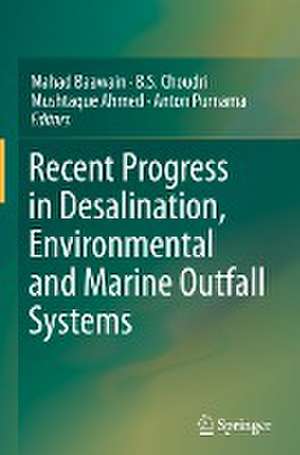Recent Progress in Desalination, Environmental and Marine Outfall Systems
Editat de Mahad Baawain, B.S. Choudri, Mushtaque Ahmed, Anton Purnamaen Limba Engleză Hardback – 23 sep 2015
Part I: Desalination Systems includes ten chapters which describe a variety of techniques and designs intended not only to minimize the impact of desalination, but also to save energy and use natural resources to maximize the output of integrated desalination systems. Among the highlights are a chapter on the use of ceramic membrane technology for sustainable oil water production; a case study on the use of solar heating systems in desalination technology in Oman; discussion of fouling and its effect on design and performance of desalination systems; a review of shore approaches and sea-lines with case studies from Australia and Germany; and a discussion of the integration of desalination technology with renewable energy for climate change abatement in the Middle East and North Africa region.
Part II: Environmental Systems includes among others a chapter on regulating the use of water resources and desalination technology on a regional scale reducing the carbon footprint of desalination, with examples from Australia; a description of desalination for irrigation in the Souss Massa region in the south of Morocco; a study of the impact of the coastal intake environment on operating conditions of thermal desalination plants in the United Arab Emirates; a discussion of hydrodynamic and thermal dispersion modeling of the effluent in a coastal channel, with a case study from Oman; and a mathematical model study of effluent disposal from a desalination plant in the marine environment at Tuticorin in India.
The book aims to inspire developments in desalination technologies which are specifically aimed at
reducing energy consumption and cost, and minimizing environmental impact.
Preț: 660.18 lei
Preț vechi: 776.67 lei
-15% Nou
Puncte Express: 990
Preț estimativ în valută:
126.32€ • 132.25$ • 104.53£
126.32€ • 132.25$ • 104.53£
Carte disponibilă
Livrare economică 17-31 martie
Preluare comenzi: 021 569.72.76
Specificații
ISBN-13: 9783319191225
ISBN-10: 3319191225
Pagini: 300
Ilustrații: XVIII, 347 p. 190 illus., 134 illus. in color.
Dimensiuni: 155 x 235 x 25 mm
Greutate: 0.97 kg
Ediția:1st ed. 2015
Editura: Springer International Publishing
Colecția Springer
Locul publicării:Cham, Switzerland
ISBN-10: 3319191225
Pagini: 300
Ilustrații: XVIII, 347 p. 190 illus., 134 illus. in color.
Dimensiuni: 155 x 235 x 25 mm
Greutate: 0.97 kg
Ediția:1st ed. 2015
Editura: Springer International Publishing
Colecția Springer
Locul publicării:Cham, Switzerland
Public țintă
ResearchCuprins
Part 1 Desalination Systems.- Chapter 1 An Overview: Desalination, Environmental and Marine Outfall Systems.- Chapter 2 Use of Ceramic Membrane Technology for Sustainable Management of Oil Production Water: A Review.- Chapter 3 Thermal Performance of a Single Slope Solar Water Still with Enhanced Solar Heating System.- Chapter 4 The Effect of Fouling on Performance and Design Aspects of Multiple-Effect Desalination Systems.- Chapter 5 Achieving the Zero-Liquid-Discharge Target Using the Integrated Membrane System for Seawater Desalination.- Chapter 6 Installation of Shore Approaches and Sea-lines Using Trenchless Methods: Technologies and Case Studies.- Chapter 7 Photocatalytic Degradation of Divalent Metals under Sunlight Irradiation using Nanoparticle TiO2 Modified Concrete Materials (Recycled Glass Cullet).- Chapter 8 Cost Effective Fouling Control in Cooling Water Intake Systems with Environmental and Operational Benefits.- Chapter 9 Chlorination By-Products and Other Quality Parameters in Desalinated Drinking Water System in Muscat .- Chapter 10 The Viability of Renewable Energy and Energy Storage as the Power Source for Municipal Scale Reverse Osmosis Desalination.- Part 2 Environmental Systems.- Chapter 11 Desalination Integration with Renewable Energy for Climate Change Abatement in the MENA Region.- Chapter 12 Reducing Carbon Footprint of Desalination: The Australian Experience.- Chapter 13 Feasibility of Using Desalination for Irrigation in the Souss Massa Region in the South of Morocco.- Chapter 14 Desalination from an Integrated Water Resources Management Perspective.- Chapter 15 Strategies for Addressing Sustainability Risks of Seawater Desalination Plants in the Arabian Gulf.- Chapter 16 Impact of the Coastal Intake Environment on the Operating Conditions of Thermal Desalination Plants: A Case Study in the United Arab Emirates.- Chapter 17 Phytoplankton Species and Associated Bacterial Populations in the Coastal Water of the UnitedArab Emirates.- Chapter 18 Environmental Quality Standards for Brine Discharge from Desalination Plants.- Chapter 19 Hydrodynamic and Thermal Dispersion Modelling of the Effluent in a Coastal Channel.- Chapter 20 Formation of Emerging Disinfection By-products by Chlorination/Chloramination of Seawater Impacted by Algal Organic Matter.- Chapter 21 Evaluation of Marine Outfall at Mumbai for Domestic Waste Discharges through Tracer Technique.- Chapter 22 Hydrodynamic Modeling: Application of Delft3D-FLOW in Santos Bay, São Paulo State, Brazil.- Chapter 23 Mathematical Model Study of the Effluent Disposal from a Desalination Plant in the Marine Environment at Tuticorin, India.
Textul de pe ultima copertă
This book collects current scientific information on advanced technologies and management practices associated with the desalination industry in the Middle East and elsewhere around the world. The book opens with introductory chapter which briefly recounts the history of desalination, and describes the current state of development in the field.
Part I: Desalination Systems includes ten chapters which describe a variety of techniques and designs intended not only to minimize the impact of desalination, but also to save energy and use natural resources to maximize the output of integrated desalination systems. Among the highlights are a chapter on the use of ceramic membrane technology for sustainable oil water production; a case study on the use of solar heating systems in desalination technology in Oman; discussion of fouling and its effect on design and performance of desalination systems; a review of shore approaches and sea-lines with case studies from Australia and Germany; and a discussion of the integration of desalination technology with renewable energy for climate change abatement in the Middle East and North Africa region.
Part II: Environmental Systems includes among others a chapter on regulating the use of water resources and desalination technology on a regional scale reducing the carbon footprint of desalination, with examples from Australia; a description of desalination for irrigation in the Souss Massa region in the south of Morocco; a study of the impact of the coastal intake environment on operating conditions of thermal desalination plants in the United Arab Emirates; a discussion of hydrodynamic and thermal dispersion modeling of the effluent in a coastal channel, with a case study from Oman; and a mathematical model study of effluent disposal from a desalination plant in the marine environment at Tuticorin in India.
The book aims to inspire developments in desalination technologies which are specifically aimed at
reducing energy consumption and cost, and minimizing environmental impact.
Part I: Desalination Systems includes ten chapters which describe a variety of techniques and designs intended not only to minimize the impact of desalination, but also to save energy and use natural resources to maximize the output of integrated desalination systems. Among the highlights are a chapter on the use of ceramic membrane technology for sustainable oil water production; a case study on the use of solar heating systems in desalination technology in Oman; discussion of fouling and its effect on design and performance of desalination systems; a review of shore approaches and sea-lines with case studies from Australia and Germany; and a discussion of the integration of desalination technology with renewable energy for climate change abatement in the Middle East and North Africa region.
Part II: Environmental Systems includes among others a chapter on regulating the use of water resources and desalination technology on a regional scale reducing the carbon footprint of desalination, with examples from Australia; a description of desalination for irrigation in the Souss Massa region in the south of Morocco; a study of the impact of the coastal intake environment on operating conditions of thermal desalination plants in the United Arab Emirates; a discussion of hydrodynamic and thermal dispersion modeling of the effluent in a coastal channel, with a case study from Oman; and a mathematical model study of effluent disposal from a desalination plant in the marine environment at Tuticorin in India.
The book aims to inspire developments in desalination technologies which are specifically aimed at
reducing energy consumption and cost, and minimizing environmental impact.
Caracteristici
Collects the latest research, advanced technologies and case studies in desalination and marine outfall systems Includes case studies from Oman, the United Arab Emirates, Australia, Germany, India and more Benefits researchers, educators, regional and national policy makers, development agencies and more












